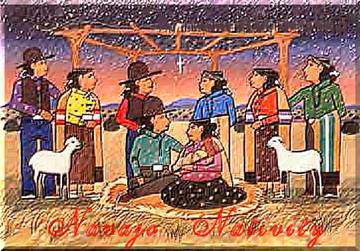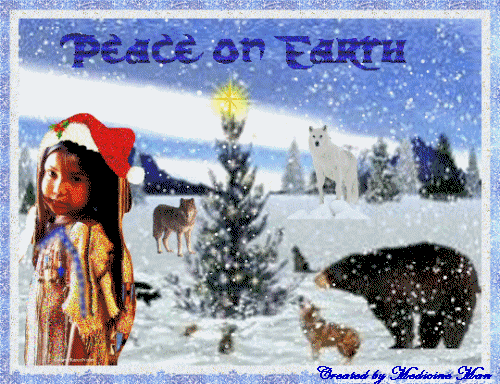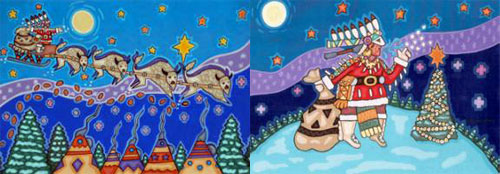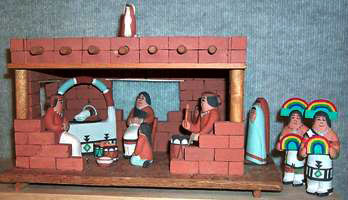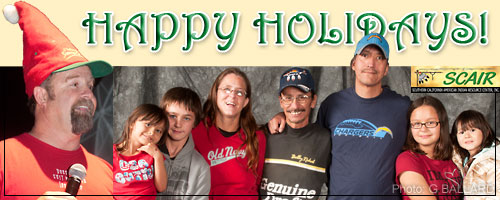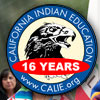 |
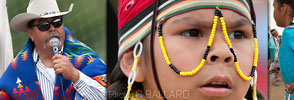 |
 |
| ABOUT CALIE MISSION STATEMENT Publishing Corner: Indian Community: Science & Wonder Indian Heros: California Indian Art: CALIE Library: Academic Financial Aid: Tribal Governments: Indian Gaming: |

American Indian Christmasby Roy Cook, Opata-Oodham, Mazopiye Wishasha: Writer, Singer, Speaker
American Indian public feasts are of great importance to Tribal people. As social events they hold the tribe together. People could meet and talk, with no distractions of daily work needing to be done. Their hearts would he warmed by all the activity and hard attitudes would soften. Feasts are also a good time for young people to see and meet each other. Also dances and dreams are an important part of our American Indian tradition. This would sometimes prepare individuals for a task, or add to the celebration of a particular event. The story of the tribe is often seen in the dances. They are very special to us. Likewise the customs give us a framework for our lives. Customs surrounding birth, death and initiation into adulthood and so on all played an important part in the development of the tribe and its members. Many Native American people found that the story of the European Christmas and Christ's birth fulfilled aspects of tribal prophecies and found the message to be consistent with the truth that was handed down by their ancestors. Over time other social customs, that were introduced to them by the European missionaries have become adapted to the native cultures and are an integral part of Tribal Christmas traditions today, just as they are in most non-Indian homes. The First Native American Christmas Carol According to Huron tradition, a Jesuit missionary priest, Fr Jean de Brebeuf, around 1640-41, wrote their first Christmas Carol. The Huron built a small chapel of fir trees and bark in honor of the manger at Bethlehem. Aloki ekwatatennonten shekwachiendaen Within a lodge of broken bark The animals at the manger were the Fox, the Buffalo and the Bear. The Huron also made a traditional tent of skins and their nativity figures were all dressed as Native Americans. This Huron Carol, originally written in the Huron language and later translated to French, has become a loved Canadian carol today. Santa Claus, St. Nicolas The American version of St. Nicholas, or Santa Claus originally came from the Dutch version called Sinter Klaas. This tradition was brought with the Dutch people who settled the East Coast of Indian America at Amsterdam, New York.
Our modern day version of how Santa Claus should look comes from the Christmas poem "A Visit From St. Nicholas" by Clement C. Moore. Written for his children in 1823, the family poem was later published for the general public and included what became the now famous 1863 picture of Santa Claus by Thomas Nast. Countless legends are told about the Patron Saint of Giving known as St. Nicholas. He has been the patron saint of Russia, Moscow, Greece, children, sailors, prisoners, bakers, pawnbrokers, shopkeepers and wolves. His gift-giving role in Christmas rites probably comes from his fame as the friend of children. This Christmas legend tells us that he also used to give anonymous donations of gold coins to persons in need. His cult spread in Europe and Christmas presents were distributed on December 6th when the celebration of St. Nicholas took place. Christmas Dances Many Tribes, including the Laguna Indians, many of whom accepted Christianity some 400 years ago, have the custom of a dance on Christmas Eve or Christmas, where gifts are offered at the Manger.
Other gift bringers come at different times of the year, often in the summertime, but the gifts are always a part of American Indian culture. Gifts are appropriate whenever the tribal gathering occasion is social or ceremonial. In many other tribes there are many representations of gifts brought to the people. All life is a gift from the creator. Our time on this earth is but a dance. Listen to the wind and the sounds of the earth, there is a song being sung each day. Celebrate life and share the gifts of the Creator. In this way it will be complete. This and at all times, for all our relations and Indian children, Mehan. Back to Roy Cook's Articles page
|
CALIF INDIAN EDU NETWORK: APAPAS.com
—
WEB SITE DESIGN
www.calie.org COPYRIGHT 2008-Present • ALL RIGHTS RESERVED
